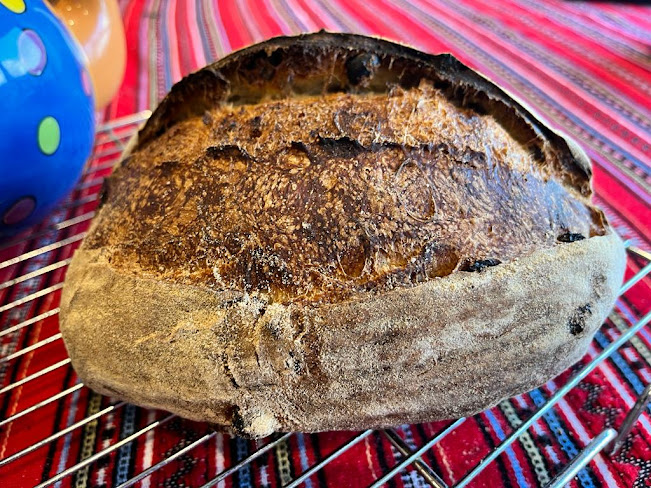ChatGPT Raisin sourdough (Easy Difficulty)
Welcome to another step-by-step recipe from BreadClub20. Why not drop by our main Facebook page by clicking here... . If you like what you see and enjoy the recipe, we hope you join us by 'Liking' and 'Subscribing'.
I've used ChatGPT for travel. It helps with routes, and itineraries and suggests specific excursions.
But I've just now used it for bread.
It was a wet Monday in November...and I asked it how it would make Raisin Sourdough.
What came out was appalling. So, I asked it a few questions, told it what I liked about what it was producing and, more importantly, what I didn't like.
And we came up with this....half human, half Android, so to speak.
See what you think.
FORMULA
For the levain:
120 gms active sourdough starter (unfed is fine)
240 gms tepid water
240 gms strong white bread flour
For the dough:
360 gms strong white bread flour
60 gms tepid water
60 gms orange juice (the juice of a large orange)
150 gms raisins
7 gms crushed sea salt (or equivalent(
1 tablespoon of honey (ChatGPT wanted to make this optional - but why not? I added it)
Hydration: total flour (flour/flour in starter)= 660 gms / total water (water/orange/water in starter) - 440 gms. Hydration 64%
1. This is potentially a same-day bake, so we see the use of a large quantity of active starter and only the option offered of bulk fermenting overnight, not as a necessity. The consequences will be a quicker fermentation and a more mild taste.
2. Instead of the usual stretching and folding, you'll note that it uses a more traditional kneading approach. This is designed to build gluten quickly and allow the fermentation to start.
3. You'll see that there's no mention of cinnamon or other spice....yes, I wondered long and hard over this and it certainly is an option. Remember that large quantities of cinnamon can affect the fermentation. However, we're using quite a quantity of starter here, so, if you do decide to add cinnamon, a teaspoon would be ideal. Add it when you add the raisins.
METHOD
The night before
The night before (8 -12 hours before)
Mix the levain (starter, water, flour) and leave at room temperature to double.
Baking Day
Add the 360 gms strong bread flour to the 60 gms tepid water.
Add the salt, honey (if used), starter mix from the night before orange juice.
Bring it together into a sticky mix and knead for a short while.
Flatten out, distribute the raisins and then fold into itself and continue kneading until you have a soft and pliable dough.
You can knead by hand or by mixer or by bread machine (use an instant start programme, e.g. 'pizza' and stop as soon as your dough has formed)
Prepare by lightly oiling a graduated bulk fermentation container.
Place the dough in the container, and note the level. Cover and put in a warm place until the dough has increased by 80% in volume.
Bulk fermentation will take as long as it takes! It will depend on the temperature but it will be quicker than if you had only used a small amount of starter. Watch the dough...not the clock. Nothing happens for a little while and then it sets off.... don't let it catch you out.
If you want, this first rise can take place overnight in the refrigerator....it's up to you.
Now, gently tip the dough out onto a floured board. Remember, this is sourdough, so rice flour tends to make life a little easier and stops the dough from becoming too sticky.
Depending on how you are going to bake and whether you want to divide the dough, prepare your bannetons. Remember that the dough is going to expand again, by about ⅓rd, so make sure your banneton can accommodate the increase in volume.
Shape the dough into boules, cover and leave to rest for 10 minutes.
Now, finally shape for the bannetons.
Cover the bannetons and return it to the warm place until it has noticeably expanded. Again, this will depend on the temperature so watch the dough, not the clock. It should take between one and two hours, depending on the temperature. The two below took a little under 2 hours at 23⁰C.
Preheat your oven to 230⁰C and preheat your baking containers. (e.g. Dutch ovens, Pyrex casseroles, terracotta baking pots, enamel roasters, etc.)
Score the dough and transfer it/them to the baking pot(s) and bake, covered for 20 minutes.
Remove the lid and continue to bake for a further 20 - 30 minutes until the bread is golden brown and hollow when tapped on the bottom.
Cool for at least an hour before slicing.
Happy Baking...or qoSlIj DatIvjaj as they'd say in Klingon!
And from the taste testers...







.jpeg)









Comments
Post a Comment